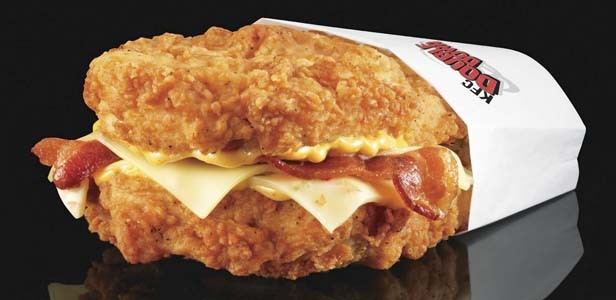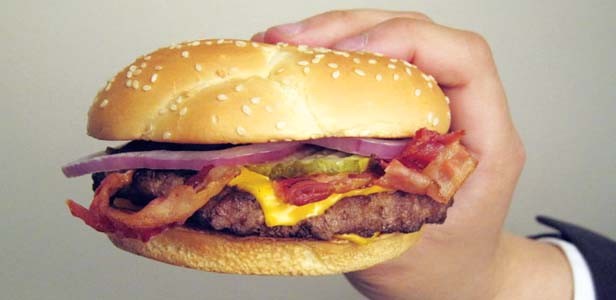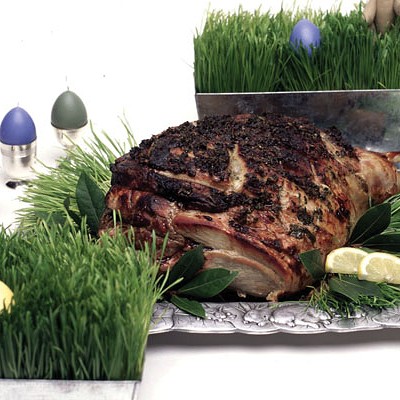It’s an all-out war. A fierce, raging battle. On one side are those who are working to modify American eating habits to become healthier and more sensible in order to combat what have become epidemic levels of obesity and other dietary-related illnesses. On the other side are prepared food industries equally determined to increase their profits by enticing us to eat more and more of their products.
Sure, prepared food industries pay lip service to “healthy eating.” The Double Down – a breadless “sandwich” of two chicken breasts, two slices of bacon and two pieces of cheese – comes with either fried or grilled chicken (although all the commercials show only the fried version). McDonald’s offers salads, as does Taco Bell (in a fried tortilla bowl). The Golden Corral has a salad bar, and sugar-free Jello and chocolate pudding, which I seriously doubt is what’s bringing in most of their customers.
Much of the campaign to improve American eating habits focuses on what people eat. That’s fine. But just as important – perhaps even more important – is how often people are eating things that should be saved for occasional indulgences and how much (a.k.a. the portion size) they’re eating – not only junk and/or fast foods, but also otherwise healthy but calorie-dense items. Surveys show that Americans trying to maintain their weight ignore portion size – and that’s a mistake.
“If people could cut down on their portion sizes, this would be the single greatest way to combat the creeping obesity epidemic,” says Madelyn Fernstrom, founding director of the University of Pittsburgh Medical Center Weight Management Center.
The size of American food portions has been on the rise for four decades, roughly paralleling the rise of obesity and other diet-related illnesses. Those cute little bottles of Coke sometimes available during the holiday season that are sold as novelties? Those used to be standard size, in fact, the only size available.
Just how much everyday portion sizes have increased is brought home to me whenever I use the custard cups I inherited from my grandmother. Buff-colored ceramic with a glaze that’s cracked with age, they’re a treasure for me in part because they’re retro-cool, but mostly because they bring back memories of suppers from my childhood. We often had desserts for weeknight dinners. Most often it was fruit, fresh in season; in colder weather it might be a baked apple or berries, cherries or peaches frozen or canned by my mother and grandmother. Sometimes, though, we’d have baked custard, chocolate pudding or tapioca, served in those ceramic cups. They hold a half-cup. I didn’t think it was an unusually small serving – it was what we always had. These days, though, what’s in those cups seems almost miniscule.
Portion size has been increasing for some time – a really long time, according to researchers Brian and Craig Wansink. Brian is director of the Cornell University Food and Brand Lab and author of Mindless Eating: Why We Eat More Than We Think. His brother, Craig, is a biblical scholar at Virginia Wesleyan College. Jesus may have been the creator of “super-sizing” when he turned a few fish and loaves of bread into sustenance enough for multitudes. But the Wansinks, whose findings were published in the online International Journal of Obesity, say that portion sizes have been “marching heavenward” for 1,000 years. Using computers, the Wasinks analyzed 52 paintings of Christ’s Last Supper from the year 1000 to the year 2000. They used the size of the plates and the food servings on them as compared with the size of the apostles’ and Christ’s heads. Under the assumption that head sizes hadn’t increased over that time period, they then gauged the serving size increases. According to the Wasinks, entrées grew by approximately 70 percent while bread increased 23 percent. The plates got larger, too – 65 percent larger.
Though the Wasinks study is fun, there’s no real evidence that people in the developed world increased their body mass index (a measure of obesity) into unhealthy levels for almost all of that 1,000 years, says Lisa R. Young, a nutrition researcher at New York University and author of The Portion Teller, a history of portion size in the 20th century. In an article she and her NYU colleague published in the Journal of Public Health, they report that U.S. portion sizes substantially began rising in the 1970s, and sharply escalated in the 1980s, a trend that continues.
According to Young and Nestle:
With the single exception of sliced white bread, all of the commonly available food portions we measured exceeded – sometimes greatly – USDA and FDA standard portions. The largest excess over USDA standards (700 percent) occurred in the cookie category, but cooked pasta, muffins, steak and bagels exceeded USDA standards by 480 percent, 333 percent, 224 percent, and 195 percent, respectively… french fries, hamburgers, and soda… current sizes are two to five times larger than the originals.
In contrast to practices that were common just 15 to 25 years ago, food companies now use larger sizes as selling points; fast-food companies promote larger items with signs, staff pins and placemats; manufacturers of diet meals such as Lean Cuisine and Weight Watchers advertise larger meal sizes; restaurant reviews refer to large portions and national chain restaurants promote large-size items directly on menus. Restaurants are using larger dinner plates, bakers are selling larger muffin tins, pizzerias are using larger pans. Identical recipes for cookies and desserts in old and new editions of classic cookbooks such as Joy of Cooking specify fewer servings. Another indicator of the trend toward larger portions is that automobile manufacturers have installed larger cup holders in newer models to accommodate the larger sizes of drink cups.
Since the 1970s, the food service industry has grown larger, and people have been eating out more; marketing has become more concentrated. Profits for most food items rise consistently when manufacturers increase product size. From a marketing standpoint, oversized packages draw attention to a new product. Large portions often seem like a bargain: 7-Eleven’s 16-oz Gulp costs just under 5 cents/oz., but a 32-oz Big Gulp is 2.7 cents/oz. The 7-Eleven Double Gulp, a 64-oz soda, contains nearly 800 kcal – an amount 10 times the size of a Coca-Cola when it was introduced.
Notably, the sizes of chain fast-food portions in Europe are smaller than those in the United States. McDonald’s [European] “Extra Large” soda portions weigh the same as the US “Large.” In 1998-1999, the largest order of french fries in the United States contained 610 calories, whereas the largest size in the United Kingdom contained 446 calories.
Overall ….portion sizes of virtually all foods and beverages prepared for immediate consumption have increased and now appear typical.
Hmm…. What if the solution to America’s eating disorder is simply to eat less – not eliminate – calorie-dense foods, and make nutritionally-poor/calorie-rich foods an occasional indulgence rather than the norm. Instead of crazy diet fads that lurch from one extreme to the other. Instead of relying on expensive programs sold by diet companies. Instead of buying low-cal, low-fat, low-carb pre-prepared foods that, even though they’re low-whatever, are awash with artificial ingredients and chemicals.
There’s lots of information in books and online about exactly how much is appropriate to eat of this or that. They’re useful guidelines, but for most of us, exactly measuring and weighing each morsel we consume is cumbersome and often impractical. Maybe we should just eat less – at least of those calorie dense-foods: go ahead and pig out all you want on non-starchy vegetables and fruits.
Could it possibly be that simple? Try it and see if it works for you.
The National Institute of Health has Proportion Distortion Quizzes that compare the size and calories of current servings with those of the past online at hp2010.nhlbihin.net/portion/.
Contact Julianne Glatz at [email protected].
Nana’s chocolate pudding
If you’ve only ever had pudding from a box, you’ll be surprised at how flavorful this homemade version is – and that it doesn’t take much more time than the pre-fab stuff. Nana used regular Dutch cocoa; I prefer Hershey’s Special Dark, and substituting dark brown sugar for white. Made with skim milk, it only has 117 calories and .25 grams of fat per serving – and still tastes plenty rich.
- 3T. cornstarch
- 3 T. cocoa
- ½ c. sugar
- ¼ tsp. salt
- 2 c. milk
- 1 tsp. pure vanilla extract
Warm the milk in the microwave until it’s warm to hot, but don’t let it come to a boil. Whisk the hot milk into the cocoa mixture and cook over medium low heat until it comes to a simmer, whisking constantly. Let simmer for about 5 minutes, until the pudding has thickened.
Remove from the heat and add the vanilla. Continue to stir for a couple minutes more so that the pudding remains smooth and no lumps form around the edges. Pour into individual ramekins or custard cups and cool to room temperature. Cover and chill thoroughly before serving. Makes six scant ½ c. servings.
Variations – these are good singly or in combination with one or both of the other variations.
Substitute dark brown sugar (Meijer’s house brand is especially good) for the white sugar.
- Mix ½ tsp. cinnamon with the dry ingredients for a Mexican touch.
- Mix ½ - 1 tsp. instant coffee or espresso powder with the dry ingredients for a mocha pudding.





















